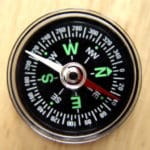The natural beauty of New York knows no bounds: the opportunities for biking, boating, and outdoor activities is nearly endless here. But have you ever stopped to consider what might be hiding nearby, out of eyesight? Things that might be waiting to be found, if only you knew where to look?
 Amongst the rocks and trees, beneath the tall grasses and logs, and within both the tourist destinations and seldom-frequented places… these places all hold secret “treasures” to be found… for those who know how to find them. Boxes, containers, tubes, and tiny vessels… some holding trinkets for trading, and others with just a record of who has found its existence… These are Geocaches and Letterboxes, awaiting those who are clever enough to find them. All over the country, Geocaching (and to a lesser extent, Letterboxing) is becoming more and more popular for adults and families, and there is plenty of fun to be had right here in the Finger Lakes Region!
Amongst the rocks and trees, beneath the tall grasses and logs, and within both the tourist destinations and seldom-frequented places… these places all hold secret “treasures” to be found… for those who know how to find them. Boxes, containers, tubes, and tiny vessels… some holding trinkets for trading, and others with just a record of who has found its existence… These are Geocaches and Letterboxes, awaiting those who are clever enough to find them. All over the country, Geocaching (and to a lesser extent, Letterboxing) is becoming more and more popular for adults and families, and there is plenty of fun to be had right here in the Finger Lakes Region!
Letterboxing
With its roots in England, Letterboxing was technically created in 1854 by William Crossing when he placed a bottle for visitors to record their presence at Cranmere Pool in Dartmoor. Building on this idea, a box was placed near the northern moor trail for hikers to leave postcards and letters for mailing by the next person to discover them. Thus the term “letterboxing” was coined.
While the first letterboxes were notoriously difficult to find, today finds thousands of them located all over the world – most are quite easily accessible. Because of their frequency, the habit of leaving letters for mailing has been put by the wayside. While some boxes now have simple sign-in logs, the popularity of rubber-stamp signatures has become the norm for this sport. Each box contains its own rubber stamp and log-book, and each visitor has their own identification stamp and logbook. Thus stamps are “traded,” documenting a visit.
Letterboxing is built on basic orienteering and pacing practices, using directionals, landmarks, and step-counting to find the prize. It is a great way to teach children the basics of map-reading, finding/following directions, and outdoor appreciation.
Geocaching
With the development of GPS technology, Geocaching is the new form of Letterboxing, and participation is
much easier: all you need is a handheld GPS unit or GPS-enabled phone! Coordinates are provided for a cache location – it is usually up to you to determine how to get there. Of course, clues and directions are often given along with the coordinates to make the find a little easier. A Geocache can be a box with a log-book and trinkets for trade, a smaller vessel with just a log and no trinkets, a very tiny (and VERY challenging-to-find) log, and even virtual locations that must be documented by photograph before their “find” is rewarded.
While the game is only 13 years old (the very first was placed on May 3, 2000), there are currently even more Geocaches than Letterboxes, as preparation and placement is much easier than with Letterboxes.
For both sports, finding the object might be as easy as stopping along the road for an easy-to-find container, visiting a library or museum, or taking a photo of yourself at a specific landmark (known as “virtual Geocaching”). More difficult Geocaches and Letterboxes may involve short to moderate hikes and harder-to-find container sizes and camouflage. The most difficult can be found in extreme placements (underground, under water, or at the end of an extensive hike), can be so minuscule in size or so well hidden that only the most diligent can find them, or may require a puzzle/riddle/code to be solved to find them! Both Geocaches and Letterboxes are usually documented with some sort of difficulty rating so that you can select those that match your skill level.
There is ample opportunity to participate in these activities here in Upstate New York. Within five miles of Trumansburg alone, there are over two dozen Geocaches (and maybe more when you consider mystery/puzzle Geocaches), and an unknown amount of Letterboxes (most that are recorded in this region are mystery boxes to be solved)! The further you get from the inn, the potential number of finds rises almost exponentially!
Secrecy is the key to both games – it is no fun blatantly advertising a location, as finding the hide is most of the fun! And we all know what happens when uncaring witnesses discover something hidden – it is usually demolished or stolen within a very short time. When you participate, please remember to preserve and respect your surroundings, and be discreet about your activities.
Is it the romance of hidden treasure? The idea of knowing a secret that may not be known to others? Or maybe you want to find those rare, beautiful spots that others seldom visit. No matter why you decide to participate, you will need to plan several bed and breakfast weekends before you run out of treasures to find!




